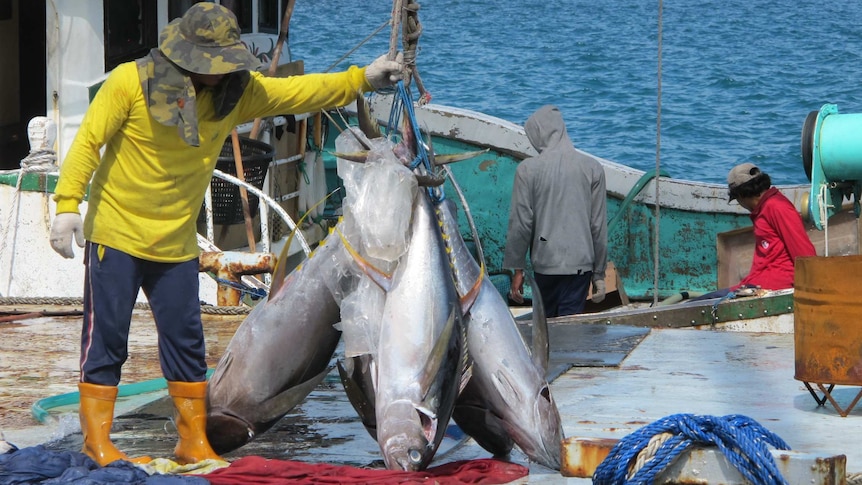
Across the vast expanse of the Pacific Ocean, a silent struggle is unfolding beneath the waves. The vital tuna, a cornerstone of both the region’s marine ecosystem and its economic stability, is facing unprecedented challenges. As ocean temperatures rise, waters acidify, and currents alter, tuna populations are being driven into new territories, placing Pacific Island nations and their essential fishing industries at risk.
A Familiar Ocean Turned Unpredictable
For the people of Palau, the ocean is not merely a resource but an intrinsic part of their identity. Ann Singeo, executive director of the Ebiil Society, a conservation group dedicated to Palau’s natural resources, highlighted this profound connection through her interviews with local fishers. “One of the questions that we ask a fisher is, what is your relation to the ocean? And most of them would answer that their relationship to the ocean is that it is their responsibility to care for the ocean,” she said.
Palau’s marine sanctuary is the sixth largest in the world. This deep-seated responsibility extends to Singeo’s own life, having grown up trolling with her father and marrying an avid fisher. In Palau, teaching children to swim before they can run underscores the pervasive presence of the ocean. However, in recent years, the familiar waters have begun to behave unpredictably.
Elders, once repositories of deep ocean knowledge, now express confusion. Fishers observe strange weather phenomena and changes in fish behavior. Singeo recounted one fisherwoman’s observation of heavy rains causing fish in shallow waters to float and die from lack of oxygen. “For over a week. And then it rains. Heavy rain, instant heavy rain that causes this phenomenon, where the fish in the shallow waters would just be floating in the water. They would die from lack of oxygen that’s being processed in the ocean.”
This phenomenon, once rare, is now occurring more frequently and extending to deeper waters, with reports of dead sharks, rays, and larger fish along the coastline. This signals that rising temperatures are impacting beyond shallow areas. The impacts of climate change are also eroding traditional knowledge. Observational cues that have guided fishing practices for millennia are no longer reliable. Fishers report that the ocean is “too warm,” and tuna, which typically follow water temperature, are no longer found in their usual seasonal grounds.
“It’s definitely affecting their knowledge of the ocean and the efficiency of their fishing practices,” Singeo said, detailing how speargun fishers now find no fish at midnight due to warm waters, and pelagic fish are absent during what should be their season.
Economic Lifeline Under Strain
The changes in tuna migration patterns are not isolated to Palau; they represent a significant concern for the entire Pacific region. Tuna fisheries are a major economic driver, generating an estimated $US500 million annually for the region through the sale of licenses to industrial fishing companies. The Western and Central Pacific Ocean region alone provides more than 50 percent of the world’s tuna catch, valued at approximately $US6 billion per year, with the majority sourced from Pacific Island Exclusive Economic Zones (EEZs).
Dr. Graham Pilling, deputy director of the Fisheries Aquaculture and Marine Ecosystems Division at SPC (the Pacific Community), highlighted the vastness of these EEZs. The combined EEZs of the 22 Pacific island countries and territories that are members of SPC span 40,000,000 km², an area over five times the size of Australia.
Dr. Graham Pilling said, “The combined EEZs of 22 Pacific nations span more than five times the size of Australia.”
Selling industrial fishing licenses to nations like the United States, Japan, and China is a crucial source of government revenue for many Pacific island nations. For Kiribati, over 70 percent of its non-aid government revenue comes from tuna access fees, and for Tokelau, it’s over 80 percent. Tuvalu, similarly, relies heavily on these fees, accounting for about 40 percent of its government revenue annually, ranging from $US35 million to $US50 million in a good year.
Simon Kofe, Tuvalu’s Minister for Transport, Energy, and Communication and previously a legal advisor for Tuvalu’s fisheries department, acknowledged the success of regional cooperation. “One of the success stories of regionalism in the Pacific is how the Pacific nations have come together to really harmonize their laws and their management measures. And the result is that the tuna stock in the western central Pacific is the last healthy fish stock in the world.”
Given tuna’s migratory nature, regional cooperation is essential for consistent conservation and management. The Vessel Day Scheme (VDS), implemented around 2010/2011 by parties to the Nauru Agreement, is a key management measure. Under the VDS, fishing days are allocated to member countries at a benchmark price of $US8,000 per day. Countries like Tuvalu sell these days to fishing companies, with a limited number of days assigned to each nation, ensuring sustainable fishing effort. Tuvalu, for example, has approximately 2,000 fishing days to sell annually.
Simon Kofe said, “Tuna stock in the western central Pacific was the last healthy fish stock in the world.”
Future Scenarios and Adaptation
Despite many years of work to get to this point, the threat of climate change looms on the horizon. Tuvalu expresses deep concern, acknowledging the potential economic impact on its budget and essential government services if fishing revenues decline. Dr. Pilling said the El Niño-Southern Oscillation (ENSO) cycle, which influences weather patterns, also dictates water temperatures in the Pacific, consequently affecting tuna distribution.
Warmer El Niño conditions push tuna eastward, while cooler La Niña conditions constrain them westward. Climate change models predict a consistent trend of warmer waters extending eastward. SPC employs scientific modeling to forecast these impacts, considering various greenhouse gas emission scenarios.
“We identify different scenarios for basically the greenhouse gas emissions that will drive climate change into the future to try and kind of bracket what the futures will look like,” Dr. Pilling said, describing the use of oceanographic and ecosystem models to predict temperature changes and their impact on tuna food sources and the tuna themselves.
Under a high-emission scenario, projections for the next 25 years indicate a decline in tuna abundance in the Pacific. “The abundance of tuna in the Pacific is going to decline. And if we look at our exclusive economic zones in the western central Pacific, on average, the decline will be about 13 percent,” Dr. Pilling said. The majority of tuna are projected to be found further east, potentially outside the current EEZs, moving onto the high seas.
This means Pacific island nations might struggle to charge fishing vessels for access, or their waters could become less attractive, directly impacting their revenue. Local fishermen are already reporting that fish stocks are moving further away, requiring them to travel greater distances.
“It’s a pretty big issue. And it’s a, it’s a concerning issue,” Dr. Pilling said.
Advocating and Adapting
Recognizing the gravity of the situation, regional efforts are intensifying. In February 2025, the Green Climate Fund announced a grant of more than $US100 million for 14 Pacific countries to help them manage the risks of climate impacts on tuna. This funding will support initiatives such as deploying Fish Aggregating Devices (FADs) near shore to concentrate tuna resources, making them easier for local communities to access for subsistence and local markets. Another key aspect is improving modeling to provide better advice on climate change impacts on tuna at a local scale.
The Western and Central Pacific Fisheries Commission (WCPFC), responsible for conserving and managing tuna in the region, has 17 Pacific Island nation members, along with countries like Australia, Canada, and China. Dr. Josie Tamate, Chair of the WCPFC, highlighted the strong regional cooperation as a cornerstone of past success in managing tuna stocks. “I think that the cooperation has been the cornerstone for the success of especially the Pacific island nation members of the FFA, and having that, the commitment is already there.”
Climate change is now a standing agenda item for the WCPFC. “We’re supporting and incorporating the scientific research into the management discussions,” Dr. Tamate explained, noting the need to adapt existing management frameworks to ensure Pacific island states can maintain their economic benefits as tuna potentially move eastward, out of their EEZs. This involves working within a complex legal and geopolitical framework to pursue climate justice for tuna-dependent economies, balancing sustainability, equity, and economic needs.
“If we do nothing now, that’s not an option. We have to do something. Each of us has a responsibility,” Dr. Tamate said, emphasizing that climate change is a global problem requiring universal action.
Despite the comprehensive work planned at regional and national levels, the Pacific contributes very little to global greenhouse gas emissions. Dr. Graham Pilling underscores that this is not just a Pacific issue, but a global challenge. “I think we all should be concerned. It’s a global challenge. And to be effective. Every country in the globe needs to be working towards the same goal.”
Mr. Kofe echoed the sentiment, hoping the world takes the message to heart. “We see the disproportionate burden that we carry in the Pacific, but unfortunately, the world doesn’t see it in that way.” He reiterated that the science and real-world impacts are clear: tuna migration patterns in the Pacific are changing. For vulnerable nations like Tuvalu, experiencing these impacts daily, the urgency is paramount.
“I just feel that the world might be too late when they finally take this issue seriously,” he said.
The Pacific’s battle for its tuna, a battle against the escalating effects of climate change, is a testament to the region’s resilience and its continued call for global responsibility. The stakes are high, not just for the economies and livelihoods of Pacific island nations, but for a vital global food source and the health of the world’s largest ocean.







